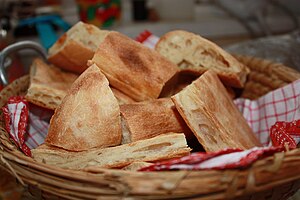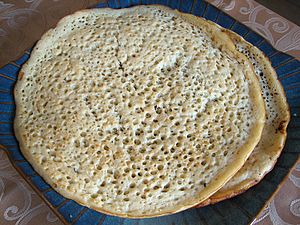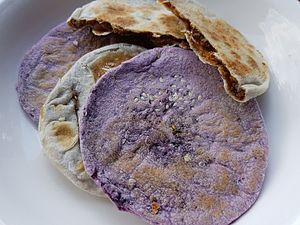フラットブレッド
Flatbread/ja
 自家製フラットブレッド | |
| Type | パン |
|---|---|
| Main ingredients | 小麦粉, 水, 塩 |
フラットブレッドは、通常、小麦粉、水、牛乳、ヨーグルトなどの液体、そして塩で作られ、薄く延ばした生地を焼いたパンである。多くのフラットブレッドは無発酵だが、ピタパンのように発酵させて作るものもある。一人前85g(約3オンス)のピタパンには234カロリーが含まれる。
フラットブレッドは厚さが1ミリメートル未満から数センチメートルと幅広く、スライスせずに手軽に食べられる。オーブンで焼いたり、熱した油で揚げたり、熱い炭火で焼いたり、熱いフライパン、タヴァ、コマール、または金属製の鉄板で調理したりでき、焼きたてを食べることも、包装して冷凍保存し後で食べることもできる。
歴史
フラットブレッドは最も初期の加工食品の一つであり、その生産の証拠はメソポタミア、古代エジプト、インダス文明の古代遺跡で発見されている。すべてのフラットブレッド製パンシステムの起源は西アジアの肥沃な三日月地帯にあるとされ、そこから世界の他の地域へと広がっていった。
2018年、ヨルダンのシュバイカ1と呼ばれるナトゥーフ文化の遺跡(ハラット・アッシュ・シャーム、黒い砂漠内)で、紀元前12,400年に遡る焦げ付いたパンくずが発見された。これは、この地域で農業が始まる約4,000年前のことである。分析により、それらはおそらく野生の大麦、アインコルン小麦、オート麦、そしてBolboschoenus glaucus(一種のイグサ)の塊茎を含むフラットブレッドのものであることが示された。
原始的な粘土オーブン(タンディール)は、セルジューク朝およびオスマン帝国時代のアナトリアで、無発酵のフラットブレッドを焼くのに広く使われており、中東各地の考古学的遺跡で発見されている。タンディールという言葉はアッカド語のtinuruに由来し、ヘブライ語とアラビア語ではtannur、トルコ語ではtandır、ウルドゥー語/ヒンディー語ではtandurとなる。楔形文字の資料から知られる数百種類のパンのうち、無発酵のtinuruパンは、加熱された円筒形オーブンの側壁にパンを貼り付けて作られていた。この種のパンは、この地域の地方の食文化の中心であり続けており、若者と女性が焼きたてのタンディールパンを分かち合うことが若い恋の象徴であるという地元の民間伝承にも反映されているが、伝統的なパン作りの文化は、特に町に住む若い世代が現代的な利便性を好む傾向にあるため、変化しつつある
List of flatbreads
Europe


- Bannock (Scotland): a quick bread baked from grain
- Bazlama (Turkey): made from wheat flour, water, and salt
- Bolo do caco (Madeira, Portugal)
- Borlengo (Italy)
- Farl (Ireland and Scotland)
- Flammkuchen/Tarte flambée (Alsace): thin bread dough rolled out in a circle or a rectangle and covered with onions and lardons
- Flatbrød (Norway): barley flour, salt and water, or potato, flour and salt, or peas flour and salt.
- Flatkaka (Iceland): rye flatbread
- Focaccia (Italy)
- Ftira (Malta)
- Gözleme (Turkey): folded over a savoury filling and fried on a griddle
- Hoggan (Cornwall): made from barley flour containing pieces of pork, and potato
- Hönökaka (Bohuslän): made from wheatmeal. The name is the commercial variant of the traditional name "bagebröd", meaning "baked bread".
- Lagana (Greece)
- Lángos (Hungary)
- Lefse (Norway)
- Oatcake (United Kingdom)
- Pane carasau (Sardinia, Italy)
- Parlenka (Bulgaria)
- Pita (Turkey)
- Pizza (Italy)
- Pogača (Balkans and Turkey)
- Pastetx (Gascony, France)
- Piadina (Italy): white flour, lard (or olive oil), salt and water
- Pinsa (Rome): wheat and other flours, such as barley, rice, oats, and millet
- Pita (Greece)
- Pită/Lipie/Turtă (Romania)
- Pichade (Menton, France)
- Pissaladière (France)
- Podpłomyk (Poland)
- Posúch (Slovakia)
- Rieska (Finland)
- Saj bread (Turkey)
- Somun and Lepina (Bosnia and Herzegovina)
- Spianata sarda (Sardinia, Italy)
- Staffordshire oatcake (England)
- Shotis Puri (Georgia)
- Tonis puri (Georgia)
- Tigella (Italy)
- Talo (France)
- Torta (Spain)
- Torta al testo (Umbria, Italy)
- Torta de Gazpacho (Spain)
- Tunnbröd (Sweden): any combination of wheat, barley and rye
- Yufka (Turkey): wheat flour, water and salt
Middle East and Africa



- Aghroum (Algeria): Berber flatbread made with semolina
- Barbari (Iran)
- Bataw (Egypt)
- Chapati (Swahili coast, Uganda)
- Eish merahrah (Egypt): made with 5–10% ground fenugreek seeds and maize
- Gurassa (bread) (Sudan)
- Harcha (Morocco): fried buttery bread made of semolinaTemplate:Citation needed
- Injera (Horn of Africa): teff flour
- Khebz (Levant)
- Khubz (Arabian Peninsula)
- Maryam's Bread (Arabian Peninsula)
- Khubz Asmr (Saudi Arabia) (Arabian Peninsula): made of wholemeal flour, yeast, and saltTemplate:Citation needed
- Khubz al-Jamri (Arabia, Northern Yemen): ash cake made by burying dough in hot ashes and embers
- Kisra (Sudan)
- Laffa (Iraq)
- Lahoh (Somalia, Djibouti, Kenya, Yemen)
- Lavash (Armenia and Iran)
- Zhingyalov Hats (Armenia): flatbread filled with herbs and spices
- Lebanese Bread (Lebanon): white flour, dried yeast, sugar, salt and waterTemplate:Citation needed
- Malooga (Yemen): water, yeast, salt and flour
- Markook (Levant)
- Matnakash (Armenia)
- Matzo (Jewish): white plain flour and water
- M'lawi (Tunisia): water, olive oil, semolina and flour
- Moroccan Frena
- Mulawah (Yemen)
- Murr (Israel)
- Muufo (Somalia)
- Ngome (Mali): millet, water and vegetable oil
- Pita (Eastern Mediterranean and Middle East)
- Sabaayad (Somalia Kenya, and Djibouti)
- Saj bread (Lebanon, Israel)
- Samoon (Iraq)
- Sangak (Iran)
- Taboon bread (Lebanon)
- Taftan (Iran)
Central Asia


- Afghan bread or "Nan" (Afghanistan)
- Bolani (Afghanistan): a vegetarian flat-bread dish
- Obi Non (Afghanistan and Uzbekistan)
- Shelpek (Kazakhstan)
- Tandoor-nan (Central Asia)
- Tandyr nan (Central Asia)
- Tapansha, Taba nan (Kazakhstan)
- Bindaeddeok (Korea): pancake made from mung bean flour
- Bing (China)
- Green onion pancake (China): made with oil and minced scallions (green onions)
- Laobing (China)
- Sanchuisanda (China)
- Shaobing (China)
South Asia

- Aloo paratha (India and Pakistan)
- Akki rotti (India)
- Appam (India): pancake made from fermented rice batter and coconut milk
- Bakarkhani (Bangladesh)
- Bhakri (India): made with water and millet flour
- Bhatura (Indian subcontinent): made with white flour, yogurt, ghee (or oil), and yeast
- Chapati (Indian subcontinent): made from atta flour (whole grain durum wheat), water
- Chili parotha (India)
- Chikkolee (India)
- Dhebra (India)
- Dosa (India): batter made from rice and black gram fried on a griddle
- Gobi paratha (India and Pakistan)
- Jolada rotti (India)
- Kalai roti (Bangladesh)
- Kaak (Pakistan)
- Kachori (Indian subcontinent)
- Kothu parotta (India)
- Kulcha (Indian subcontinent)
- Luchi (India and Bangladesh): fine maida flour with water and a spoonful of ghee
- Makki di roti (India and Pakistan)
- Mughlai paratha (India and Bangladesh)
- Naan (Indian subcontinent and Central Asia): leavened with yeast, unlike Roti bread
- Paratha (Indian subcontinent)
- Parotta (India and Sri Lanka)
- Pathiri (India): is a traditional roti that originated from Malabar cuisine.
- Pesarattu (India): pancake made from green gram (Mung) batter
- Phulka (Indian subcontinent): made from whole wheat flour, water and salt. It is like a baked variety of Puri.
- Poli (India): made from whole wheat flour, water and salt. It is folded and layered round flat bread.
- Pol roti (Sri Lanka): made from scraped coconut and wheat or kurakkan flour, with green chillis and onion
- Puri (Indian subcontinent): prepared from dough of atta and salt
- Ragi rotti (India and Sri Lanka)
- Roast paan (Sri Lanka): bread mixture baked in a flat mold, producing, literally, a 'flat' bread.Template:Citation needed
- Roti (Indian subcontinent)
- Rumali roti (Indian subcontinent)
- Sheermal (Indian subcontinent and Iran)
- Taftan (Indian subcontinent and Iran)
- Aparon (Philippines)
- Bánh (Vietnam)
- Kabkab (Philippines)
- Khanom buang (Thailand): rice flour
- Kiping (Philippines)
- Piaya (Philippines)
- Roti prata (Singapore)
- Roti canai (Brunei, Indonesia, Malaysia, Singapore and Thailand)
- Roti tissue (Indonesia and Malaysia)
Americas


- Arepa (Colombia, Venezuela): flat, unleavened bread made of cornmeal
- Bammy (Jamaica): made from grated cassava root or cassava flour and salt
- Bannock (food): a variety of flat quick bread or any large, round article baked or cooked from grain
- Beiju (Brazil): made from tapioca
- Casabe (South America, Caribbean): made from bitter cassava root
- Frybread (North America)
- Johnnycake (North America and Caribbean)
- Native American Flatbread (North America): made from maize flour in a traditional style of early Native Americans; now topped with ground beef, vegetables, beans and cheese
- Pan de semita (Mexico)
- Piki (Hopi): made very thin from blue corn and baked on a hot flat stone
- Ploye (Canada): thin crepe made from buckwheat flour, traditional to the Brayons of northeast New Brunswick.
- Pupusa (El Salvador)
- Tortilla (Mexico, Central and South America): either as corn tortilla or flour tortilla
- Tortilla de Rescoldo (Chile): wheat flour based bread, traditionally baked in the coals of a campfire
Australia
- Damper (traditionally)
Further reading
- 2005. "High-Profile Flatbreads - Say Goodbye to Insipid White Bread When Tortillas and Flatbreads Come to Town". FOOD PRODUCT DESIGN -NORTHBROOK-. 15, no. 1: 96–114. ISSN 1065-772X.
- 2008. "Flatbreads Old World: Meets New Flatbreads from All Over the World-Including Tortillas, Arepas and Naan-Are the Newest Hot Ticket in Both Retail and Foodservice Products". FOOD PRODUCT DESIGN -NORTHBROOK-. 18, no. 11: 38–43.
- 2008. "Storied Breads: With a Continuing Focus on Food Origin, Flatbreads Offer Manufacturers a Way to Tempt Consumers with Authentic Products Celebrating the Oldest-Known Bread Traditions". BAKING AND SNACK. 30, no. 7: 35–42. ISSN 1092-0447.
- 2011. "Flat-Out in Love with Flatbread Here Are 5 Reasons Foodservice Is Smitten with Flatbreads". FOOD MANAGEMENT -NEW YORK THEN CLEVELAND OH-. 46, no. 11: 30–35. ISSN 0091-018X.
- Alford, Jeffrey, and Naomi Duguid. Flatbreads and Flavors: A Baker's Atlas. New York: W. Morrow, 1995. Summary: Recipes for more than sixty varieties of flatbreads along with 150 recipes for traditional accompaniments to the breads, including chutneys, curries, salsas, stews, mezze, smorgasbord, kebabs, etc.
- Craddock, Anne. Textural Characteristics of Bagels and Ethnic Flatbreads. 1998. Thesis. 124 leaves.
- German, Donna Rathmell. Flatbreads from Around the World. San Leandro, Calif: Bristol Pub, 1994.
- Hansen, Eric. 2015. "Fabled Flatbreads of Uzbekistan." Aramco World. July/August 2015. Pages 32–39.
- Helou, Anissa. Savory Baking from the Mediterranean: Focaccias, Flatbreads, Rusks, Tarts, and Other Breads. New York: William Morrow, 2007.
- Kahlon, Talwinder Singh, and Mei-Chen Maggie Chiu. 2014. "Ancient Whole Grain Gluten-Free Flatbreads". Food and Nutrition Sciences. 05, no. 17: 1717–1724.
| この記事は、クリエイティブ・コモンズ・表示・継承ライセンス3.0のもとで公表されたウィキペディアの項目Flatbread(25 May 2025, at 08:40編集記事参照)を翻訳して二次利用しています。 |




